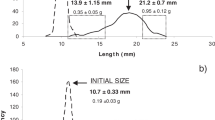Abstract
WHILE engaged in investigations (carried out with the aid of a Government grant) on the oyster beds in the River Blackwater, a jelly-fish (about 8 cms. in diameter) kept as a pet was given large numbers of oyster larvæ to see what it would do with them. From the fate of the oyster larvæ it was at once seen that the adult jelly-fish, Aurelia aurita, feeds definitely and—normally—automatically on smaller plankton organisms in a manner resembling that in which bivalves, some worms, and other animals feed on plankton. On adding the oyster larvæ to the jar in which the jelly-fish was living, it was observed that the larvæ were quickly formed up on the ex-umbrella surface of the jelly-fish in lines embedded in mucus and were also swept on to and retained in quantity on the oral arms. This immediately raised suspicion, and the jelly-fish was thereupon fed at intervals and carefully observed.1 It was found that small plankton organisms of about the size of oyster larvae were collected from the ex-umbrella surface of the jelly-fish and carried, mainly by ciliary action, towards the rim of the umbrella. The rhythmic waves of contraction of the bell or umbrella assist in carrying the strings of collected plankton-food to the edge of the umbrella, whence they are transferred—by a process not yet fully worked out—either to the oral arms or to the under surface of the rim of the umbrella. At the rim of the umbrella in this jelly-fish there is narrow curtain fringe cut normally into 8 segments so that one portion of the fringe lies between two of the marginal sense-organs (tentaculocysts). The fringe therefore resembles that often seen at the rim of a parasol except that it consists normally of 8 segments. The tentacles arise from the edge of the umbrella at the base of and outside this fringe.
This is a preview of subscription content, access via your institution
Access options
Subscribe to this journal
Receive 51 print issues and online access
$199.00 per year
only $3.90 per issue
Buy this article
- Purchase on Springer Link
- Instant access to full article PDF
Prices may be subject to local taxes which are calculated during checkout
Similar content being viewed by others
References
Gemmill (Proc. Roy. Phys. Soc. Edin., vol. xx. part 5, 1921) records some interesting notes on food-capture and ciliation in the ephyra of the jelly-fish, which are not, however, the same as in the adult, the structure of which is more complex
Author information
Authors and Affiliations
Rights and permissions
About this article
Cite this article
ORTON, J. The Mode of Feeding of the Jelly-fish, Aurelia aurita, on the Smaller Organisms in the Plankton. Nature 110, 178–179 (1922). https://doi.org/10.1038/110178a0
Issue Date:
DOI: https://doi.org/10.1038/110178a0
This article is cited by
-
Sex determination and differentiation in Aurelia sp.1: the absence of temperature dependence
Journal of Oceanology and Limnology (2018)
-
Field observations of four Aurelia labiata jellyfish behaviours: swimming down in response to low salinity pre-empted swimming up in response to touch, but animal and plant materials were captured equally
Hydrobiologia (2014)
-
Morphology, fluid motion and predation by the scyphomedusa Aurelia aurita
Marine Biology (1994)
-
Wirbellose Meerestiere als Parasiten, Kommensalen oder Symbionten in oder an Scyphomedusen
Helgoländer Wissenschaftliche Meeresuntersuchungen (1976)
-
The Amphipod, Hyperia galba, an Ectoparasite of the Jelly-fish, Cyanea capillata
Nature (1959)
Comments
By submitting a comment you agree to abide by our Terms and Community Guidelines. If you find something abusive or that does not comply with our terms or guidelines please flag it as inappropriate.



